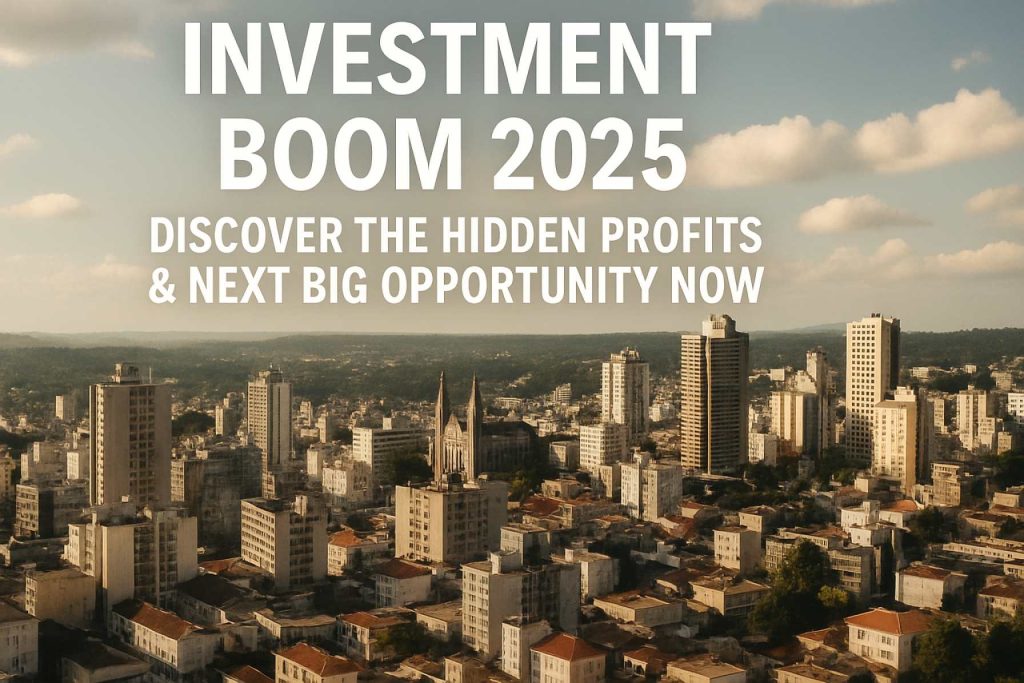
Table of Contents
- Caxias at a Glance: Economic and Demographic Overview
- Real Estate Hotspots: Where Opportunity Awaits in 2025
- Major Infrastructure Projects Shaping Caxias’ Future
- Legal & Regulatory Shifts: What Investors Must Know in 2025
- Key Sectors Driving Growth: From Industry to Innovation
- Tech Transformation: Digitalization and Smart City Initiatives
- Market Forecasts: Price Trends and Asset Appreciation to 2030
- Financing and Tax Incentives for Investors
- Risks, Challenges, and How to Navigate Them
- Future Outlook: Expert Predictions for Caxias through 2030
- Sources & References
Caxias at a Glance: Economic and Demographic Overview
Caxias, officially known as Caxias do Sul, is a major economic hub in the state of Rio Grande do Sul, Brazil. As of 2025, the city stands out as one of the country’s most industrialized municipalities, with a strong presence in the metal-mechanic, furniture, and agribusiness sectors. According to the latest demographic estimates by the Instituto Brasileiro de Geografia e Estatística (IBGE), Caxias do Sul’s population has surpassed 530,000, with a steady annual growth rate just above 1%. This expanding population fuels demand across housing, services, and retail segments, making the city an attractive destination for investment.
The industrial sector remains the backbone of Caxias’ economy, contributing over 30% to the city’s GDP. Large employers such as Randon S.A. Implementos e Participações and Marcopolo S.A. anchor the local manufacturing ecosystem, while the city’s diversified base includes emerging technology and service enterprises. Caxias do Sul is also a leader in wine production, with the surrounding Serra Gaúcha region being responsible for more than 85% of Brazil’s national output, according to the Instituto Brasileiro do Vinho (IBRAVIN).
Recent years have seen a notable uptick in real estate activity, with residential and commercial launches increasing to meet population and business demand. The Caixa Econômica Federal reports that mortgage origination in Caxias grew by over 10% in 2024, outpacing national averages and reflecting robust investor confidence. Local government initiatives, such as infrastructure improvements under the Prefeitura Municipal de Caxias do Sul’s 2023–2026 strategic plan, are modernizing urban mobility and expanding utilities, further bolstering the city’s long-term investment prospects.
Legal frameworks are supportive of both domestic and foreign investment. The city adheres to Brazil’s national real estate regulations, with streamlined property registration processes implemented by the Conselho Nacional de Justiça (CNJ) and local notary offices. Incentives for industrial expansion, such as tax reductions and land grants, are available through municipal programs like the “Programa de Desenvolvimento Econômico de Caxias do Sul” (Prefeitura Municipal de Caxias do Sul).
Looking ahead, projections from the Federação das Indústrias do Estado do Rio Grande do Sul (FIERGS) anticipate continued GDP growth for Caxias in 2025 and beyond, driven by innovation, export growth, and urban expansion. The combination of a skilled workforce, dynamic economic base, and pro-investment policies positions Caxias as a compelling choice for both real estate and broader business investments in the coming years.
Real Estate Hotspots: Where Opportunity Awaits in 2025
Caxias, a dynamic municipality in Maranhão, has been steadily gaining traction as a real estate hotspot, drawing a diverse array of investors in 2025. The city’s strategic geographic position—serving as a key hub in the Maranhão-Piauí corridor—has been bolstered by infrastructure upgrades, government incentives, and a robust demand for both residential and commercial developments.
Recent data from Caixa Econômica Federal indicate that housing credit approvals in Caxias have increased by over 18% year-on-year, reflecting a surge in both affordable and mid-range housing projects. This growth is spurred in part by the federal “Minha Casa, Minha Vida” program, whose reforms in 2023 expanded eligibility and streamlined financing, directly benefiting Caxias’s burgeoning neighborhoods.
On the legislative front, the Maranhão state government implemented urban development policies in late 2024, including expedited licensing for new construction and tax incentives for sustainable building initiatives. According to the Governo do Estado do Maranhão, these measures have attracted new developers and accelerated project timelines, especially in districts such as Cohab, Centro, and Baixinha.
Commercial real estate is also witnessing a transformation. With the inauguration of the new Business Park Caxias complex in 2024, managed by Serviço Brasileiro de Apoio às Micro e Pequenas Empresas (SEBRAE Maranhão), local entrepreneurship and logistics businesses have found a modern base of operations. This, combined with the proximity to major highways and the planned improvements to the city’s intermodal terminal, has significantly increased demand for warehouse and office space.
The rental market is responding accordingly, with data from Conselho Regional de Corretores de Imóveis do Maranhão (CRECI-MA) showing a 12% rise in average rental yields compared to 2023. This trend is expected to continue as population growth and internal migration fuel demand for both short- and long-term accommodations.
Looking ahead, the outlook for Caxias remains highly favorable. Public and private investment in infrastructure, combined with regulatory support and a growing consumer base, are set to maintain upward momentum in the city’s real estate sector into 2026 and beyond. Investors are advised to monitor ongoing legislative adjustments and target emerging micro-markets within Caxias for optimal returns.
Major Infrastructure Projects Shaping Caxias’ Future
Caxias is experiencing a new wave of infrastructure investments that are reshaping its economic landscape and making it an increasingly attractive destination for investors in 2025 and beyond. The city, strategically located in Maranhão, has become a focal point for development due to both public and private sector initiatives aimed at strengthening logistics, urban mobility, energy, and public services.
One of the most significant ongoing projects is the expansion and modernization of the Departamento Nacional de Infraestrutura de Transportes (DNIT) road network in the region. The duplication and improvement of BR-316, a critical highway connecting Caxias to Teresina and other key urban centers, is slated for completion in late 2025. This upgrade is expected to streamline the flow of goods and reduce transportation costs, directly benefitting logistics, agribusiness, and manufacturing sectors.
In urban infrastructure, the municipal government has partnered with Caixa Econômica Federal to finance the ongoing expansion of Caxias’ sanitation and water supply systems. These upgrades are part of the broader federal framework set forth by the new Legal Framework for Basic Sanitation (Law 14.026/2020), which aims to universalize access to clean water and sewage treatment by 2033. With several projects already underway, Caxias is on track to meet interim targets by 2027, boosting the quality of life and supporting residential and industrial growth.
The city’s energy infrastructure is also being reinforced. Equatorial Energia is investing in grid modernization and the deployment of smart metering technologies, anticipating increased demand from both new residential areas and expanding industrial zones. These enhancements are expected to improve supply reliability and open opportunities for renewable energy integration in the coming years.
Another notable development is the modernization of the Caxias Municipal Airport, with planned investments in runway extension and facilities upgrades. This project, supported by the state government, aims to enable the airport to handle larger aircraft and increased passenger traffic—positioning Caxias as a regional hub for business and tourism by 2026.
Taken together, these infrastructure projects are transforming Caxias’ investment landscape. As these initiatives reach completion, the city is expected to see continued appreciation in land and property values, greater industrial diversification, and a more dynamic local economy—making 2025 and the years ahead a promising period for investors.
Legal & Regulatory Shifts: What Investors Must Know in 2025
Caxias, a prominent city in Maranhão, Brazil, has seen a dynamic legal and regulatory landscape emerge for investors, particularly in real estate, infrastructure, and agribusiness. The city’s 2025 outlook is shaped by both state and federal reforms, alongside municipal initiatives designed to foster a more attractive climate for domestic and foreign investment.
One of the most significant legal developments is the implementation of the new urban zoning plan, approved in late 2024. This plan reorganizes land use, encourages mixed-use development, and streamlines environmental licensing procedures. Investors benefit from simplified approval processes for commercial, industrial, and residential projects, reducing bureaucratic delays that historically hampered market entry (Prefeitura Municipal de Caxias).
Additionally, changes to Maranhão’s state tax incentives under the Programa Mais Empresas continue into 2025. The program, administered by the state government, grants reductions on ICMS (state value-added tax) for select industries, including logistics, food processing, and green energy. These incentives aim to attract new capital and encourage expansion projects by existing players (Secretaria de Indústria, Comércio e Energia do Maranhão).
On the federal level, the new Real Estate Investment Trust (FII) regulations, enacted by the Brazilian Securities Commission in early 2025, provide enhanced protections for minority investors and clarify rules on foreign participation. These rules, in effect nationwide including Caxias, are expected to boost transparency and liquidity in the property market (Comissão de Valores Mobiliários).
Environmental compliance remains crucial. The 2023 update to Brazil’s Forest Code, which is being enforced more rigorously in Maranhão, requires clear documentation and restoration plans for any developments affecting native vegetation. This is particularly relevant for investors in agribusiness and real estate, as non-compliance can result in significant fines or project delays (Instituto Brasileiro do Meio Ambiente e dos Recursos Naturais Renováveis).
Looking ahead, the municipal government has signaled further digitalization of land registry and business licensing by 2026, aiming for greater transparency and efficiency. Combined, these legal and regulatory shifts position Caxias as a more predictable and attractive environment for investors, provided that new compliance requirements are carefully observed and integrated into due diligence processes.
Key Sectors Driving Growth: From Industry to Innovation
Caxias do Sul, situated in the heart of Brazil’s southern region, is a prominent example of economic diversification and sustained industrial growth. Traditionally recognized for its robust manufacturing and metalworking sectors, the city continues to evolve, positioning itself as a strategic hub for new investments in 2025 and beyond.
The manufacturing sector remains a cornerstone of Caxias do Sul’s economy, with a particular emphasis on automotive parts, machinery, and metal products. According to data from the Federação das Indústrias do Estado do Rio Grande do Sul, Caxias do Sul’s industrial output ranks among the highest in the state, contributing significantly to regional GDP. The city’s established network of suppliers and logistics infrastructure further attracts multinational corporations, particularly in the automotive supply chain.
Agribusiness and food processing represent another key growth area. The region’s fertile lands support a thriving agribusiness sector, with major investments in food processing, packaging, and distribution. Companies such as Fras-le and Randon have diversified beyond their traditional industrial bases to explore agritech solutions, reflecting a broader trend towards innovation-driven growth.
Recent local government initiatives have amplified Caxias do Sul’s attractiveness for investors. The city’s 2023-2026 Strategic Development Plan, overseen by the Prefeitura Municipal de Caxias do Sul, focuses on supporting technology parks and incubators, fostering a climate for startups in IT, automation, and advanced manufacturing. The Movelsul Brasil trade fair, held biennially in Caxias, continues to draw international attention to the city’s innovative furniture and design sector, highlighting its role as a creative industry leader.
Legal frameworks have also been updated to stimulate business activity. The passing of the 2023 Municipal Law on Innovation and Technology Incentives offers tax breaks and simplified licensing for companies investing in research, development, and innovation. This aligns with federal incentives from the Financiadora de Estudos e Projetos (FINEP), which provides grants and financing for technological advancement projects within Caxias do Sul’s industrial ecosystem.
Looking ahead, Caxias do Sul is expected to deepen its role as a nexus for industry and innovation. The city’s strong industrial heritage, expanding tech ecosystem, and proactive regulatory environment suggest a positive outlook for investors seeking both traditional opportunities and emerging sectors in the coming years.
Tech Transformation: Digitalization and Smart City Initiatives
Caxias do Sul, a major city in southern Brazil, is experiencing a significant digital transformation that is shaping its investment landscape. The municipal government and private sector are collaborating to implement smart city initiatives aimed at improving urban infrastructure, public services, and economic competitiveness. These efforts are attracting both domestic and foreign investors interested in technology-driven growth.
A central pillar of this transformation is the Programa Caxias Digital, launched by the Prefeitura de Caxias do Sul (City Hall of Caxias do Sul). The program focuses on expanding public Wi-Fi, digitizing administrative services, and supporting local tech startups. In 2024, the city reported that over 80% of municipal services—from business licensing to tax payments—had transitioned to digital platforms, streamlining processes for investors and entrepreneurs.
The city is also home to the Universidade de Caxias do Sul Technology Park (TecnoUCS), which fosters innovation through partnerships with local industry, research institutions, and government. The park provides incubation for startups in AI, IoT, and automation, and has seen a 25% increase in new tech companies over the past two years. This growth is supported by strategic funding from the Banco Nacional de Desenvolvimento Econômico e Social (BNDES) and local business associations.
Legally, Caxias do Sul aligns with the national Lei nº 14.133/2021, which modernizes public procurement and encourages innovation through regulatory sandboxes and public-private partnerships (PPPs). The city has leveraged these frameworks to launch smart mobility projects, such as integrated digital ticketing and real-time traffic monitoring, in partnership with companies like Unidas and local mobility startups.
Looking to 2025 and beyond, Caxias do Sul aims to implement a city-wide IoT sensor network for smart lighting, waste management, and environmental monitoring. These projects are detailed in the city’s Plano de Transformação Digital, which outlines investment incentives, including tax credits and fast-track permitting for tech infrastructure. The plan anticipates a 30% increase in technology sector employment by 2026, bolstering the city’s position as an innovation hub in southern Brazil.
- Strong municipal commitment to digitalization through Prefeitura de Caxias do Sul initiatives
- Expanding tech ecosystem anchored by Universidade de Caxias do Sul
- Legal frameworks support innovation and public-private partnerships
- Favored sectors: IoT, AI, mobility, and public service digitization
Market Forecasts: Price Trends and Asset Appreciation to 2030
The real estate market in Caxias, Maranhão, is poised for a period of stable growth through 2030, reflecting broader trends in Brazil’s secondary cities. Recent data from the Caixa Econômica Federal highlight a steady increase in residential property values in the city, driven by local economic development, infrastructure projects, and demographic expansion. Between 2020 and 2024, Caxias registered an average annual price appreciation of 6-8% for urban residential units, outpacing the national average for smaller municipalities.
For 2025 and beyond, several factors are expected to support continued asset appreciation in Caxias. According to the Instituto Brasileiro de Geografia e Estatística (IBGE), population growth in the region is projected to remain above 1% annually, increasing demand for both housing and commercial real estate. Meanwhile, the federal Minha Casa, Minha Vida program, relaunched with expanded funding in 2023, is set to deliver thousands of new affordable housing units in Maranhão by 2027, stimulating construction sector activity and ancillary investments (Caixa Econômica Federal).
Legal frameworks have also evolved to enhance investor security. The updated Lei do Inquilinato (Law No. 8.245/1991) continues to streamline rental agreements and expedite dispute resolution, making Caxias an attractive market for buy-to-let investors (Presidência da República). The city’s urban master plan, revised in 2023, has earmarked new zones for mixed-use and residential development, thereby unlocking additional land supply for future projects (Prefeitura de Caxias).
Looking toward 2030, the Secretaria de Estado da Cultura do Maranhão notes ongoing investments in local infrastructure—particularly in education, health, and transportation corridors—are expected to increase the city’s appeal for both residents and businesses. This, in turn, should sustain moderate but positive annual property value gains. While short-term volatility may occur due to macroeconomic cycles or shifts in federal interest rates (as set by the Banco Central do Brasil), the medium- to long-term outlook for real estate in Caxias remains robust, with cumulative appreciation forecast to outpace inflation through 2030.
Financing and Tax Incentives for Investors
Caxias, a prominent city in the state of Maranhão, Brazil, has been actively implementing policies and programs to attract investment through a range of financing options and tax incentives. As of 2025, both local and federal initiatives continue to shape the investment landscape, providing opportunities for domestic and foreign investors.
A key driver for investment in Caxias is the municipal adherence to the “Lei de Incentivo ao Desenvolvimento Econômico” (Economic Development Incentive Law), which offers targeted tax reductions and exemptions for companies establishing or expanding operations in strategic sectors such as industry, agribusiness, logistics, and renewable energy. Under this legal framework, eligible enterprises may benefit from reductions in the Imposto sobre Serviços (ISS) and exemptions from municipal property taxes (IPTU) for a period of up to 10 years, depending on the scale and impact of the project. The Prefeitura de Caxias regularly updates the list of priority investment sectors and publishes application guidelines for these incentives.
On the state level, Maranhão’s “Programa Mais Empresas” further supports investors by offering incentives such as reductions in the ICMS (state value-added tax) for new industrial projects and for those expanding existing capacities. Recent updates to this program, effective in 2025, have streamlined application processes and broadened eligibility, especially for projects generating employment and utilizing local suppliers. The Secretaria de Indústria, Comércio e Energia do Maranhão (SEINC) manages this program and provides up-to-date information on qualifying criteria and fiscal benefits.
For financing, a variety of credit lines are available through national development banks such as Banco Nacional de Desenvolvimento Econômico e Social (BNDES), which offers long-term loans with favorable rates for infrastructure, manufacturing, and sustainable projects in regions like Caxias. In 2025, BNDES has prioritized projects aligned with environmental sustainability and social development, in line with federal policies. Additionally, the Banco da Amazônia and regional agencies provide microcredit and special lines for small and medium-sized enterprises (SMEs) active in Maranhão.
Looking ahead, Caxias is expected to benefit from anticipated federal tax reforms, which aim to simplify Brazil’s complex tax system and may further reduce fiscal burdens for investors in the coming years. Stakeholders are advised to monitor updates from the Receita Federal do Brasil for the latest regulatory changes impacting investment decisions.
Risks, Challenges, and How to Navigate Them
Investing in Caxias presents a range of opportunities, but also involves specific risks and challenges that prospective investors must carefully consider. As Caxias continues to grow as a regional economic hub in northeastern Brazil, understanding the evolving landscape in 2025 and beyond is crucial for making informed decisions.
One primary challenge is regulatory complexity. Real estate transactions in Brazil are governed by both federal and municipal laws, which can be intricate and subject to change. In 2023, the federal government updated property registration procedures to simplify transactions, but implementation at the municipal level in Caxias remains uneven. Investors should monitor local updates from the Prefeitura Municipal de Caxias to stay abreast of zoning changes, building codes, and tax incentives or liabilities, as these can impact project viability and returns.
Economic volatility is another notable risk. While Caxias has shown resilience and growth, Brazil’s broader economic indicators—such as inflation and interest rates—can affect local market dynamics. The Banco Central do Brasil continues to adjust the Selic rate in response to inflationary pressures, influencing mortgage costs and the overall cost of capital for real estate development and other investments. Investors should factor in potential fluctuations in financing conditions over the next few years.
Land tenure and title security are also significant concerns. Although Brazil’s legal framework aims to ensure transparency, some regions, including parts of Maranhão state, have historically faced challenges with informal land occupation and disputed titles. It is essential to conduct thorough due diligence and secure clear documentation from the Registro de Imóveis before committing capital.
For foreign investors, regulatory hurdles include restrictions on rural land acquisition and additional requirements for compliance with the Receita Federal (Brazilian Federal Revenue). Currency fluctuations and cross-border tax considerations should also be evaluated, as the real’s value can shift due to both local and global macroeconomic factors.
To navigate these risks, investors are advised to:
- Engage reputable local legal counsel and real estate agencies registered with the Conselho Regional de Corretores de Imóveis (CRECI).
- Perform comprehensive due diligence on property titles and regulatory compliance.
- Monitor economic indicators published by the Instituto Brasileiro de Geografia e Estatística (IBGE) and follow updates from the Comissão de Valores Mobiliários (CVM) for broader market insights.
- Consider gradual entry strategies or partnerships with established local entities to mitigate exposure to market volatility and regulatory uncertainty.
By proactively addressing these challenges, investors can better position themselves to capitalize on the growth potential in Caxias through 2025 and the years ahead.
Future Outlook: Expert Predictions for Caxias through 2030
Investing in Caxias, a prominent municipality in the state of Maranhão, Brazil, is increasingly on the radar of both domestic and international investors. The city, known for its strategic location and growing urban infrastructure, is witnessing a surge in development activity. As Caxias approaches 2030, sector experts, public policy planners, and financial institutions are closely monitoring trends and legislative measures that are shaping its investment climate.
From 2025 onward, projections for Caxias are buoyed by a combination of infrastructure expansions and favorable regulatory frameworks. The city’s ongoing inclusion in the Ministério dos Transportes’s portfolio for logistics corridor improvements is improving access to regional and national markets. These infrastructure upgrades are expected to lower transportation costs for local industries and catalyze further investments in logistics and warehousing sectors.
On the legal front, recent years have seen Maranhão adapt its investment incentives, aligning with national initiatives such as the Lei de Licitações e Contratos Administrativos (Law No. 14.133/2021), which modernizes public procurement and fosters greater transparency and efficiency in public-private partnerships. Caxias’ local government is leveraging these frameworks to attract capital into housing, sanitation, and renewable energy projects by offering fiscal benefits and streamlined permitting processes (Governo do Estado do Maranhão).
In real estate, the Caixa Econômica Federal continues to facilitate financing for residential and commercial developments, with a focus on affordable housing and mixed-use projects. According to recent municipal data, the value of building permits issued in Caxias grew by approximately 18% between 2022 and 2024, signaling robust construction activity and strong investor confidence (Prefeitura de Caxias).
Looking ahead, experts from the Câmara Brasileira da Indústria da Construção predict steady growth for Caxias through 2030, citing demographic expansion, industrial diversification, and proactive urban planning. The city’s population is projected to rise by 1.5% annually, fueling demand for new housing and retail space. Moreover, the planned expansion of the local industrial district and government-backed innovation hubs are expected to attract technology and light manufacturing firms, diversifying the investment landscape.
In summary, the outlook for investing in Caxias through 2030 is positive, underpinned by legal modernization, infrastructure upgrades, and demographic growth. Investors can expect a dynamic environment with expanding opportunities, particularly in real estate, logistics, and the green economy.
Sources & References
- Instituto Brasileiro de Geografia e Estatística (IBGE)
- Randon S.A. Implementos e Participações
- Caixa Econômica Federal
- Conselho Nacional de Justiça (CNJ)
- Serviço Brasileiro de Apoio às Micro e Pequenas Empresas (SEBRAE Maranhão)
- Conselho Regional de Corretores de Imóveis do Maranhão (CRECI-MA)
- Equatorial Energia
- Caxias Municipal Airport
- Fras-le
- Movelsul Brasil
- Financiadora de Estudos e Projetos (FINEP)
- Universidade de Caxias do Sul
- Banco Nacional de Desenvolvimento Econômico e Social (BNDES)
- Prefeitura de Caxias
- Banco Central do Brasil
- Banco da Amazônia
- Conselho Regional de Corretores de Imóveis (CRECI)



